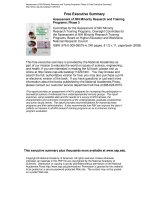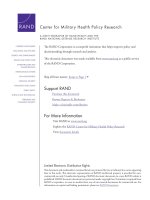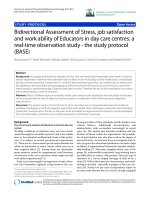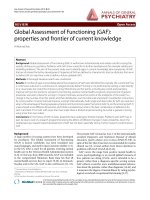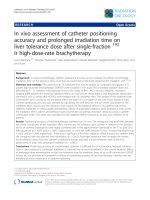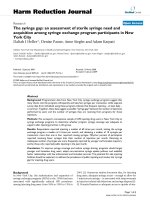ASSESSMENT OF HAND HYGIENE PRACTICE AND FACTOR AFFECTING COMPLIANCE AMONG NURSES IN BLACK LION SPECIALIZED REFERRAL HOSPITAL, ADDIS ABABA, ETHIOPIA
Bạn đang xem bản rút gọn của tài liệu. Xem và tải ngay bản đầy đủ của tài liệu tại đây (1.29 MB, 57 trang )
ADDIS ABABA UNIVERSITY
COLLEGE OF HEALTH SCIENCES
SCHOOL OF ALLIED HEALTH SCIENCES
DEPARMENT OF NURSING AND MIDWIFERY
ASSESSMENT OF HAND HYGIENE PRACTICE AND FACTOR AFFECTING
COMPLIANCE AMONG NURSES IN BLACK LION SPECIALIZED
REFERRAL HOSPITAL, ADDIS ABABA, ETHIOPIA.
BY: ABAYNESH NEGEWO (BSCN)
A thesis submitted to the department of nursing and midwifery, in partial
fulfillment of the requirements for masters degree in adult health nursing
Advisor: YosiefTsige (Msc N)
Co-Advisor: Fikertemariam Abebe (MSc N)
JUNE 2017
ADDIS ABABA ETHIOPIA
ADDIS ABABA UNIVERSITY
COLLEGE OF HEALTH SCIENCE
SCHOOL OF ALLIED HEALTH
DEPARTMENT OF NURSING AND MIDWIFERY
ASSESSMENT OF HAND HYGIENE PRACTICE AND FACTOR AFFECTING
COMPLIANCE AMONG NURSES IN BLACK LION SPECIALIZED REFERAL HOSPITAL
ADDIS ABABA, ETHIOPIA.
BY:
ABAYNESH NEGEWO
ADVISOR:
YOSIEF TSIGE(MSC N)
FIKERTEMARIAM ABEBE(MSC N)
A THESIS SUBMITTED TO THE DEPARTMENT OF NURSING AND MIDWIFERY, IN
PARTIAL FULFILLMENT OF THE REQUIREMENTS FOR MASTERS DEGREE IN
ADULT HEALTH NURSING
JUN, 2017
ADDIS ABABA, EHIOPIA
Approval by Board of Examiners
THIS MSCN THEISIS BY ABAYNESH NEGEWO SERITI ACCEPTED IN ITS PRESENTED
FORM BY BOARD OF EXAMINERS IN SATISFING THESIS REQUIREMENT FOR THE
DEGREE OF SCIENCE IN ADULT HEALTH NURSING.
Internal examiner
----------------------------
--------------
------------------
Full name
Rank
Signature
------------------Date
Advisor
YosiefTsige
Full name
FikertemariamAbebe
Full name
i
(MSc N)
Rank
(MSc N)
Rank
---------------Signature
---------------Signature
-----------------Date
-----------------Date
Abstract
Background:Hand hygiene is an important measure to prevent and control infection
particularly in developing countries, the identification of several risk factors associated with poor
hand hygiene compliance is extreme importance. Alcohol based hand rube (ABHR) is simple
measure to prevent the transmission of infection.
This institutional based cross- sectional study focus on describing hand hygiene practice of
nurses and provides base line information on the area.
Objective:To assess hand hygiene practices among Nurses in Black Lion Specialized Referral
Hospital, Addis Ababa Ethiopia.
Methods: Institution based quantitative cross sectional study design was used to assess hand
hygiene practice and factoraffecting compliance among Nurses in Black Lion Specialized
Referral Hospital. A total of 288Nurses were included and selected by simple random sampling.
Data collection was made by using self-administered structured questionnaire.The collected data
was checked visually for its completeness and the response were coded and entered into the
computer using EPI info version 3.5.1. Statistical package, and the 10% of the response was
randomly selected and check for the consistency of data entry. Then data were exported to
windows of Statistical Package for Social Science (SPSS) version 20 for data
analysis.Descriptive statistics, bivariate logistic and multivariate logistic regression analysis was
done to see association between factors and hand hygiene practice.
Result: A Total of 288 study participants filled the questionnaires with a response rate of 100%.
Hand hygiene compliance of nurses was found 79% having knowledge about hand hygiene
compliance(AOR[95%CI]= 2.873[1.258, 6.56]),availability of soap and water(AOR[95%CI]=
0.324[0.155, 0.678]), availability of ABHR(AOR[95%CI]= 0.293[0.125, 0.686]), availability of
towel/tissue paper(AOR[95%CI]= 3.314[1.587, 6.918]), were significantly associated with hand
hygiene compliance.
Conclusions: Nurses good hand hygiene compliance was indicated ‘after’ caring for a
patient whereas poor hand hygiene compliance was reported ‘before’ having direct
contact with a patient.
Nurses hand hygiene practice was influenced by the knowledge they have for hand
hygiene indications as per hand hygiene guideline.
There was no statistical significant variations on hand hygiene practice score across
nurses in different wards
Key word:hand hygiene practice; Knowledge; Nurses.
ii
Acknowledgement
First and for most I would like to give my special thanks to Addis Ababa University college of
Health Sciences and allied school of nursing and midwifery . I wish to express my sincerest and
warmest gratitude to my advisor YosiefTsgie( MSN) and FekirtemariamAbebe (Msc N) who
guided me throughout the study processvery patiently and carried the main responsibility of the
study. Without your encouragement, I would never have continued my study. You always had
time for helping me in stressingsituations during this study process.
I owe my most grateful thanks toBlack Lion Specialized Referral Hospital sponsored me to
continue my education.Finally, I would like to thankGod.
iii
Table of contents
page No
APPROVAL BY BOARD OF EXAMINERS………………………………………………...... i
ABSTRACT………………………………………………………………………......................ii
ACKNOWLEDGEMENT……………………………………………………………………….iii
LIST OF TABLES…………………………………………………………………...………......vi
LIST OF FIGUR……………………………………………………………………….………..vii
ACRONOMS……………………………………………………………………………….......viii
1. INTRODUCTION……………………………………..………….…………………………...1
1.1.Background…………………………………………………………………………………...1
1.2. Statement of the problem ……………………………………………………………………2
1.3. Significance of the study ……………………………………………………………............4
2. LITERATURE REVIEW………………………………………………………………………5
2.1. Knowledge of hand hygiene …………………………………………………………………6
2.2. Hand hygiene practices ………………………………………………………………………7
2.3. Factors influencing hand hygiene compliance ……………………………………………….8
2.4. Conceptual framework ……………………………………………………………………...10
3.OBJECTIVES…………………………………………………………………………...……..11
3.1. General objective……………………………………………………………………………11
3.2. Specific objective …………………………………………………………………………...11
4. METHODOLOGY……………………………………………………………………............12
4.1. Study Area and period ……………………………………………………………………...12
4.2. Study Design ……………………………………………………………………………….12
4.3 Population ……………………………………………………………………………..........12
4.3.1. Source population ………………………………………………………………………...12
4.3.2. Study Population ………………………………………………………………................13
4.3.2.1. Inclusion Criteria ……………………………………………………………………….13
4.3.2.2. Exclusion criteria ……………………………………………………………………….13
4.4. Sampling ……………………………………………………………………………………13
iv
4.4. 1.Sample Size Determination ………………………………………………………………13
4.4.2. Sampling Procedure ………………………………………………………………………15
4.5. Method of data collection ……………………………………………………………..........16
4.6. Study Variables ……………………………………………………………………….........16
4.6.1. Dependent variables ………………………………………………………………………16
4.6.2. Independent variables …………………………………………………………………….16
4.7. Operational Definition ……………………………………………………………………...17
4.8. Data processing and analysis ……………………………………………………………….17
4.9. Data quality control …………………………………………………………………………18
4.10. Ethical consideration ………………………………………………………………………18
4.11. Dissemination of the results ……………………………………………………………….18
5. Result……………………………………………………………………………….................19
6. Discussion……………………………………………………………………………………..34
7. Strength and limitation………………………………………………………………..36
8. Conclusion………………………………………………………………………………..…...37
9. Recommendation…………………..………………………………………………………….38
Reference………………………………………………………………………………………...39
Annex I. English version information sheet and consent form ………………………………....44
Annex II. Questionnaire..………………………………………………………………………...46
Annex III. Declaration…………………………………………………………………………...49
v
LIST OF TABLES
page No
Table 1.Distribution of socio demographic characteristics of respondents in Black Lion
Specialized Hospital; Addis Ababa, Ethiopia, March 1- April 1, 2017 ……………….. 20
Table 2.Distribution of environmental factors among Nurses in Black Lion Specialized
Hospital; Addis Ababa, Ethiopia, March 1- April 1, 2017 ……………………………..21
Table 3.Bivariate analysis of comparing knowledge with appropriate hand hygiene among
Nurses in Black Lion Specialized Hospital; Addis Ababa, Ethiopia, March1- April 1,2017
……………………………………………………………………………………………..23
Table 4.Self-reported practices of hand hygiene among Nurses in Black Lion Specialized
Hospital; Addis Ababa, Ethiopia, March 1- April 1, 2017……………………………….26
Table 5.Mean scores on knowledge, and practices of hand hygiene among Nurses in Black Lion
Specialized Hospital; Addis Ababa, Ethiopia, March 1- April 1, 2017 ………………….27
Table 6.Association of hand hygiene practice with socio - demographic factors among Nurses in
Black lion Specialized Referral Hospital; Addis Ababa, Ethiopia, March 1 – April 1, 2017
………………………………………………………………………………………….. 30
Table 7.Association of hand hygiene practice with environmental factors among Nurses in Black
Lion Specialized Referral Hospital; Addis Ababa, Ethiopia, March 1- April 1, 2017 …… 31
Table 8.Summary of logistic regression analysis of Socio- demographic, knowledge,and
environmental factors on hand hygiene practice among Nurses in Black Lion Specialized
Hospital in Addis Ababa, Ethiopia, March 1- April 1, 2017. ………………………………..33
vi
LIST OF FIGURE
page No
Figure 1.Conceptual frame work ……………………………………………………….10
Figure2. Sampling prouder………………………………………………………………15
Figure 3. Percentage of hand hygiene knowledge correct answer……………………….24
Figure4. Percentage of overall knowledge of hand hygiene practice…………………….24
Figure5. Percentages of mean score on practice………………………………………….28
Figure6. Percentage of hand hygiene compliance………………………………………...28
vii
ACRONYMS
ABHR= Alcohol Based Hand Rub
AOR=
Adjusted Odds Ratio
BLSRH= Black Lion Specialized Referral Hospital
CDC=
Center of Disease Control
COR=
Crude Odd Ratio
CSA=
Central Statistical Agency
HCAIs= Health Care Associated Infections
HBV=
Hepatitis B Virus
HCV=
Hepatitis C Virus
HH=
Hand Hygiene
HHP=
Hand Hygiene Practice
HHQ=
Hand Hygiene Questionnaire
MOH=
Ministry Of Health
MRSA= Methicillin Resistance Staffilo Aurous
NMC=
Nursing and Midwifery Council
SPSS=
Statistical Package for Social Science
viii
INTRODUCTION
1.1. Back ground
Hand hygiene is a core element of patient safety for the prevention ofHealth care Associated
Infections (HCAIs) and spread of anti microbial resistance.Its promotion represents a challenge
that requires a multimodal strategy. Handhygiene prevents cross infection in hospitals, butHealth
Care worker (HCWs)adherence to hand hygiene guidelines is poor. Easy, timely access to both
handhygiene and skin protection is necessary for satisfactory hand hygiene behavior(1).
Alcohol based hand rub may be better than traditional hand washing as theyrequire less time,
acts faster, are less irritating, and contribute to sustainedimprovement in compliance associated
with decreased infection rates (1).
Hand hygiene is a general term that applies to either hand washing with plain soap and water,
antiseptic soap and water, antiseptic hand rub or surgical hand antisepsis. One of the most
significant, current discussions in healthcare delivery in hospitals is HCAI, sometimes called
hospital acquired infection (2) or nosocomial infections, HCAIs are defined as infections that
occur as a result of health care interventions in any healthcare setting where care is delivered (3).
Hand washing is the most effective way of preventing the spread of infectious diseases. But
despite a Joint Commission requirement that Centers for Disease Control and Prevention hand
hygiene guidelines be implemented in hospitals, compliance among health care workers remains
low(4).
The reasons of lack of compliance to hand washing include: lack of appropriate equipment, low
staff to patient ratios, allergies to hand washing products, insufficient knowledge among staff
about risks and procedures, the time required and casual attitudes among HCWs towards biosafety(4).
The WHO strongly emphasize the essential need for hand hygiene during health care delivery, to
avoid possible infection and subsequent complications; hence ‘ Clean Care is Safe Care ‘
programme was launched by WHO in 2005 as part of the ‘ First Global patient safety Challenge
‘ (5).With this regard in Ethiopia has also launched the SAVE LIVES: Clean Your Hands
campaign under the leadership of the Ministry of Health (6).
In the developed world infection prevention programs that include hand-hygiene as a basic
means have been implemented in every single hospital decades ago but this is not yet true for
many countries in the developing world where infection control policies are not in place or
poorly funded (7); nosocomial infection and colonization by Methicillin Resistant
Staphylococcus Aurous have become increasingly common during the past two decades.
Althoughhand hygiene methods are widely publicized and simple (8), the prevalence of these
infections continues to rise and poses a challenge to healthcare providers. Healthcare associated
infections due to poor hand hygiene has been linked to an unacceptably high level of morbidity,
mortality and healthcare costs. In developing countries health care associated infection
prevalence is found to be as high as 19% (9).
Hand hygiene should be considered before invasive procedures, after contact with contaminated
devices or materials, and with high risk, infectious patients. Moreover, claim that hand hygiene
should be advocated before beginning work, at the end of work, and after visiting the rest room
(10).
The recommendation on hand hygiene has been updated, and hand washing has been replaced
by hand-rub as the standard of care. It has been suggested that the optimal duration of hand
washing is between 30 seconds and one minute as a minimum and a maximum range
respectively (11). It is also demonstrated that alcohol-based hand antiseptics are used worldwide
for their rapid antimicrobial effects, broad-spectrum coverage, better tolerability, and ease of
application (11).
The hand hygiene practices of HCWs have longbeen the main vector for nosocomial infection in
hospitals. So study to examineinfluences on risk judgment from the individual differences in
knowledge levelsand health beliefs among HCWs is important (12).
1.2. Statement of the problem
Nurses are professionally and ethically accountable for their actions. The Nursing and Midwifery
Council (NMC’s) . Code of Standards and Conduct . requires nurses and midwives to . provide
high standard of practice and care at all times (13). Yet, despite the momentum for hand
hygiene, some nurses are still presenting with low compliance because they perceive it as not
their problem, that it is something to do with infection control staff and they have to deal with it
(14), (15).
Furthermore, Nazarkoindicates that nurses often fail to practice hand hygiene because they are
busy and they feel hand hygiene takes up precious time(16).
In addition, nurses often perceive that gloves can be used as an alternative to hand hygiene. They
usually tend to remove the gloves without washing their hands or use the same gloves to deliver
intended care to multiple patients. Even when they remove their gloves, only 20% of nurses
actually clean their hands (17). Moreover, Canham ,Kampf& Loffler claim that nurses avoid
hand hygiene because they are frightened that skin problems such as dermatitis could develop,
especially with alcohol hand-rubs(18,19).
Hand hygiene prior to and following patient contact is a key infection control strategy included
in many official national and international infection control guidelines (20).
Most infection control programs in developing countries with limited resources are understaffed
and hand washing depends mostly in having soap, towels, and sinks available (21).Poor
compliance with hand hygiene is common among HCWs (21).
The provision of healthcare worldwide is always associated with a potential range of safety
problems and patients remain vulnerable to unintentional harm in hospitals because of poor hand
hygiene (22).
Over 1.4 million people worldwide suffer from infections acquired in hospital(23). More over
annually in the United States,approximately 2 million patients develop HCAI, and nearly
90,000 of these patients are estimated to die; this ranks HAIas the fifth leading cause of death in
acute care hospitals (24).
The burden is substantial in developed countries, where it affects from 5% to 15% of
hospitalized patients in regular wards and as many as 50% or more of patients in intensive care
units (25).In developing countries, the magnitude of the problem remains underestimated or even
unknown largely because HCAI diagnosis is complex and surveillance activities to guide
interventions require expertise and resources(26).
In Sub-Saharan countries the problems associated withpatient safety is often hampered by
inadequate data.However, prevalence studies on hospital-widehealthcare-associated infection
from some Africancountries reported high infection rates (Mali 18.9%,Tanzania 14.8%, Algeria
9.8%) with patients undergoingsurgery being the most frequently affected). In addition to
HCAIs, developing countries are hit hard by HIV/AIDSpandemic hepatitis B virus and hepatitis
C virusinfections .In resource-poor settings, rates of infection canexceed 20% (27).
Hospital wide health care associated infection prevalencevaried between 2.5% and 14.5% in
Algeria, Burkinafaso,Senegal and Tanzania. Over all Health Care- associated infection( HCAI)
cumulative incidencein surgical ward ranges from 5.7% to 45.8 % in studiesconducted in
Ethiopia and Nigeria. (28)
HAI is also a major public health problem in Ethiopia and their prevention has been made a
priority as reported by a study on 1383 obstetrics and gynecologic patients at a referral hospital
in north west Ethiopia, 246 (17.8%) developed hospital acquired infections (29).
The same is true in Ethiopia that the HCAI is a major problem that needs attention and action to
improve Hand Hygiene practice. Hence, Ethiopia in general and in Addis Ababa in particular,
the problem of health care associated infection is attributed to be common in health institutions
even though there was no detail study done in this area.
1.3. Significance of the study
Since nurses are present 24 hours a day, 7 days a week in the healthcare setting, it is essential to
comply with hand hygiene policy and maintain patient safety.
Globally millions of people suffer from infections acquired in hospitals(23).On top of these,
unless appropriate hand hygiene practice is not in place among Nurses, it justifies that they can
be the source of infection for clients.
Yet, fewstudies were conducted among Nurses. Therefore; this study were designed to assess the
practice and associated factors of hand hygiene compliance among Nurses. It aims to contribute
in filling information gaps on the hand hygiene practice issue that uses for prevention of both
Nurses and patients from getting hospital acquired infections so that morbidity, mortality and
unnecessary excess medical costs are minimized; in addition it can also serve as base line
information to undertake studies on similar settings.
2.LITERATURE REVIEW
the work of Florence Nightingale during the Crimean war, when she called for basic public
health in a military hospital in Scutari in 1854. Herinterventions to improve personal hygiene,
cleanliness in the hospital environment, living conditions and food, led to a decrease in the
number of deaths. She was one of the first who identified the relationship between nursing and
infection control (30).
Hand hygiene was thought to be a key factor in reducing hospital acquired infection (31). The
battle with HAI started when the Hungarian obstetrician, Semmelweis, observed that puerperal
fever was more common on a maternity ward, where physicians and medical students provided
care to women in labour, than it was on the ward where midwives assisted deliveries. He noted
that physicians and medical students were contaminating their hands while performing autopsies
and later attending the examination of women without hand washing (29).
Despite high magnitude of HAI and the importance of adherence to infection control policies,
proper hand hygiene practice has remained unacceptably low (15). Hand hygiene compliance
rates in different developed countries rarely exceed 50% (30). For instance, figures show that in
the USA it is 50%, in Switzerland 42% and in the UK 32% (32). Hence, poor compliance has
resulted in high morbidity and mortality. In the USA, there are between 1.7 and 2 million people
who contract HAI and 88 to 99 thousand deaths are attributed to HAI annually. Furthermore,
HAI affects nearly 10% of hospitalized patients and presents major challenges in healthcare
facilities. Consequently, annual medical expenses have increased in the USA to approximately $
4.5 billion (24).
In Canada approximately 8 thousand patients die from HAI annually. Canadian hospitals spend
up to $100 million per year treating patients with HAI (4). European countries also have a high
percentage of HAI: in the UK, for example, each year approximately 9% of people admitted to
hospital contract HAI; this is one of the highest percentages in Europe (34). The estimated
number of deaths due to HAI among hospitalized patients in the UK is 500 patients annually
(32). The situation is even worse in developing countries including Ethiopia, where resources
and facilities are limited.
A number of factors have been reported to contribute to poor hand hygiene compliance including
limited availability and accessibility of hand hygiene facilities such as sinks, time required to
perform hand hygiene, patient‘s condition, effects of hand hygiene products on the skin and
inadequate knowledge of the guidelines heavy workloads, performing activities with crosstransmission, glove use, discourage. In developing settings, inadequate access to soap and water,
and limited provision of sinks are hindrance to perform hand hygiene at the points of care (12).
In an observational study, which measured the rates of compliance of hand hygiene before and
during implementation of a program of hand hygiene improvement in Geneva, Switzerland;
resulted in an increase in the rate of compliance from 48% to 66% over a three-year period and
significant decreases in the number of hospital acquired infections from 29% to 17% and
Meticillin Resistance StaffilococcusAuros (MRSA) carrier or attack rate of MRSA(35).
According to researchers the results from a survey conducted across 14 developing countries to
evaluate the problem and size of HAI, showed a wide range of nosocomial infection, from 3 –
13.4% in different hospitals (36). However, another study conducted in developing countries,
have reported a higher rate of HAI, 6 – 27%(13). In our setting, as reported by a study on 1383
obstetrics and gynecologic patients at a referral hospital in North West Ethiopia, 246 (17.8%)
developed hospital acquired infections (37).
2.1.Knowledge of hand hygiene
In a French study of 350 students, including 107 medical students, nursing students had a better
overall score compared to medical students in the knowledge of hand hygiene, standard
precautions and nosocomial infections (38).
In Birmingham, UK, medical students were assessed for their knowledge of HAI, of which 48%
participated. This study assessed knowledge of hand hygiene, the use of gloves, venipuncture.
Just under half felt that not enough emphasis was placed on infection prevention and control.
Again, on assessment of knowledge of nearly 500 medical students in Iran, scores were
approximately 66% (39).
In Saudi Arabia the average awareness regarding the positive indications of hand hygiene was
56%. Rests of the 44% of students were either not sure or unaware of the indications of hand
hygiene; only 29% of students were able to identify all the five indications for hand hygiene in
the questionnaire(40).
In a Greek study on practices of hand hygiene found that nursing students scored higher overall
in terms of knowledge but the delivery of education on hand hygiene was different between
medical and nursing students. Nursing students had more lectures, tutorials and lecture notes
compared to the medical students, and there was a greater use of published guidelines, posters
and the internet amongst nursing students (41).
2.2.Hand hygiene practices
Among different hospital specialties, intensive care units (ICU) are consistently found to have
the highest prevalence rate of HAIs, ranging from 13-26% [17-20], when compared to the usual
figure of 5-10% reported in other units in the hospitals, [21-24]. Yet, HCWs in intensive care
units were also having the lowest Hand Hygiene (HH) compliance rate (36%, median=40%50%) when compared with staffs working in other specialties (median=50-60%) (42).
with regard to gender, hand hygiene was performed by male students on 24 out of 144 occasions
(compliance—16.7%) and by females on 17 out of 96 occasions (compliance—17.7%) resulting
in average compliance of 17% indicates that females had better hand hygiene practices than
males(41) and different scholars has been noted as there was no association between hand
hygiene practice and HCWs‘ age (43).
It is therefore important that practitioners are provided with appropriate education, training and
support to enhance knowledge, understanding and skills in order to increase the safety and
quality of care delivered to patients (44). To overcome barriers of hand hygiene compliance, it is
widelyacknoledged that hand hygiene education is the cornerstone of effective practice (45).
However, factors associated with poor hand hygiene during clinical years‘ of training has not
been investigated.
In conclusion several studies indicated that failure to perform appropriate hand hygiene is
considered to be the leading cause of health care–associated infections and the spread of
multidrug-resistant microorganisms.
2.3.Factors influencing hand hygiene compliance
Factors that may influence poor compliance to hand hygiene have been determined objectively in
several epidemiological and observational studies. In the survey conducted so far, investigators
identified predictors of poor compliance to recommended hand hygiene measures during routine
patient care.
Predicting variables include professional category, working in an intensive-care unit, being male
hospital ward, time of day/week, and type and intensity of patient care, skin irritation caused by
hand hygiene agents, inaccessible hand hygiene supplies, interference with HCW–patient
relationships, patient needs perceived as a priority over hand hygiene, wearing of gloves,
forgetfulness, lack of knowledge of guidelines, lack of recognition of hand hygiene opportunities
during patient care, and lack of awareness of the risk of cross-transmission of pathogens,
insufficient time for hand hygiene, high workload and understaffing, lack of role models and lack
of scientific information showing a definitive impact of improved hand hygiene on HAI rates,
lack of knowledge about the appropriateness, efficacy and understanding of the use of hand
hygiene and skin care protection agents contribute to poor hand hygiene performance.
At the institutional level; the lack of written hand hygiene guidelines, available or suitable hand
hygiene agents, skin care promotion/agents or hand hygiene facilities, lack of culture or tradition
of adherence, and the lack of administrative leadership, sanctions, rewards or support, lack of
institutional priority for hand hygiene, lack of institutional safety climate, and lack of active
participation in hand-constitute barriers to good hand hygiene promotion at individual or
institution level, and lack of an institutional safety climate hygiene compliance.
According to United States Centers of Disease Control and Prevention Control (CDC) and
WHO, ‘ Hand hygiene is the single most important means of preventing the spread of infection. ‘
The CDC guideline specifies that hand hygiene should occur with any patient contact and
HCW‘s hand should be washed with a non-antimicrobial soap and water or, an antimicrobial
soap and water when hands are visibly soiled, or contaminated. If hands are not visibly soiled,
HCW‘s can use an alcohol-based hand rub for routinely decontaminating hand in clinical
situations as described in literature
The CDC (2009) guidelines make a number of recommendations in relation to hand hygiene,
these are:
• Visibly dirty hands should be cleansed via hand washing with water and soap or an antiseptic
agent, because hand rubs whilst having an antiseptic action, do not remove soil from the hands.
The rinsing action of hand washing is required in this instance.
• Routine hand washing, for example prior to patient contact, requires hands to be washed for a
minimum of 15 seconds with water and an antiseptic agent.
• Health care workers should use hand creams to reduce the incidence of skin damage, as
damaged skin harbors more microorganisms than undamaged skin.
• Health care workers should not use hot water to wash their hands as it has a drying, damaging
effect on the skin.
• After application of an alcohol-based hand rub, the hands should be rubbed together until dry.
• Following hand washing, the skin can be dried with paper towel or single use cloth towel, but
multiple-use cloth towels of the hanging or roll type should be avoided.
• If hands are not visibly soiled or contaminated with blood, body fluids or other proteinaceous
material, alcohol-based hand rubs should be used prior to and following direct patient contact,
prior to donning and after removing gloves, prior to non-surgical insertion of invasive devices,
following contact with bodily excretions and wound dressings, and after contact with inanimate
objects in the immediate vicinity of the patient.
Hand hygiene is the single most clinical and cost effective measure for reducing the risk of
transmission of infectious diseases in healthcare setting worldwide (46).A great deal of research
has been conducted examining factors influencing health care workers’ compliance with hand
hygiene guidelines, there is no research on Nursing ‘ hand hygiene practice and associated
factors
in the Ethiopian setting. Therefore the purpose of this study is to assess hand hygiene
practice and factor affecting compliance among nurses.
Socio demographic
characteristics of the
Nurse (age, gender, Educat/
level, Experience year,
department of working,
total time spent on clinical
working
Nurses risk
perception (beliefs,
attitudes, behavior)
Knowledge about
hand hygiene
guideline
Patient flow (lack of
time, interference to
perform hand
hygiene)
Hand hygiene
practice
Availability and
accessibility of
hygiene facilities
in working area
Organizational factors
Training/education Perceived
commitment of management to safety
Presence of policy strategies and
budget for infection prevention
Figure 1 Conceptual framework adopted from social cognitive theory (47)
3.OBJECTIVES
3.1. General objective:
To assess the hand hygiene practices among Nurses in Black Lion Specialized Referral Hospital,
Addis Ababa Ethiopia, 2017 G.C.
3.2. Specific objective:
1. To describe the hand hygiene practices among Nurses in Black Lion Specialized
Referral Hospital, Addis Ababa Ethiopia, 2017G.C.
2. To assess the reasons for non compliance in hand hygiene practices among
Nurses in Black Lion Specialized Referral Hospital, Addis Ababa, Ethiopia, 2017.
3. To assess knowledge of nurses in Black Lion Specialized Referral Hospital, Addis Ababa,
Ethiopia, 20017.
4.METHODOLOGY
4.1. Study Area and period
The study was conducted from March 1to April 1, 2017.
This study was conduct at Black Loin Specialized Referral Hospital (BLSRH). BLSRH was
chosen since it is currently available tertiary teaching hospital in Ethiopia, which is found in
Addis Ababa Ledetakefeleketema. Addis Ababa is the capital city of Ethiopia. The hospital has
different units and departments which occupy different type of health workers among thus 820 of
them are nurses .
4.2.Study Design
Institutional based cross-sectional quantitative study design was conducted to assess hand
hygiene practice and factor affecting compliance among nurses.
4.3 Population
4.3.1. Source population
The source populations were all health workers who are working in BLSRH.
4.3.2. Study Population
The study populations wereallNurses who are working in Black Lion Specialized referral
Hospital.
4.3.2.1. Inclusion Criteria
The Nurses, Who are selected by simple random sampling technique, work at least for one
month before commencement of the study was recruited,
4.3.2.2. Exclusion criteria
Nurses those who have sick, newly enrolled nurses with less than six months of stay in working
area, and refuse to participatewas immediately be excluded from the study.
4.4. Sampling4.4. 1.Sample Size Determination
The actual sample size for the study was determined by using the formula for single population
proportion by assuming 5% marginal error (d), 95% confidence interval, ( alpha=0.05) and ,
p=50% the previous research not done on this issue. Based on the above information the total
initial sample size was calculated by using the formula;
(Z α 2) pq
2
d2
Where;
ni=
ni =require initial sample size,
Zα =critical value for normal distribution at 95 % confidence interval which equals to 1.96
2
(Z value at alpha =0.05)
P= proportion of the Nurses who are aware of Nosocomial infection
q=proportion of the Nurses who are not aware of Nosocomial infection.
d= marginal error (0.05).
ni = (1.96)2 x (0.5)(0.5)=384ni = 384
(0.05)2
Since the sampling was calculated from finite population (N<10,000), it will need finite
population correction. Therefore; by using correction formula, final (nf) sample size were:
nf = ni
1 + ni
N
nf= 384
1+ 384
820
=261.54nf =262
Where nf is the final sample size, ni is the initial sample size determine using the above formula
and N is the size of the source population during data collection 820 By considering 10%
non response rate, the total sample size were288.
(I.e.nf= 262+ 262x10 = 288.2
100
4.4.2. Sampling Procedure
288 samples were selected by using simple random(Lotterymethod) according to
clinical area of participants in divided department.
Figure 2. Schematic representation of sampling procedure
288
Out Pt’
144
IN. Pt’
144
N/n=288/2
=144
Medic
al 24
Surgica
l&Orto
23
ICU
30
Pedi
Ward 18
Cardiac
Unit 10
Gyni&oby
25
Oncology
24
Gento&Urinar
y12 Unit
Endocrin
e Unit 8
Hemato
logy 8
OR 34
Key
-N=Total sample size
-n= the selected nurses in the OPD and ward
Chest
Unit 11
ENT 4
Renal
Unit
12
Pedi OPD
6
Dermat
ology 9
Emergency
24
Neurolo
gy 6
4.5. Study Variables
4.5.1. Dependent variables
In this study the dependent variables were:
hand hygiene practice
4.5.2. Independent variables
In this study the independent variables were: Socio demographic factor; gender, age, department, total time spent on clinical working,
educational level, experience year, department of working.
Patient flow; lack of time, interference to perform hand hygiene.
Nurses Risk perception; beliefs, attitudes, behavior.
Availability of accessibility of Hygiene facilities in working.
Knowledge about hand hygiene guideline.
the mean value The reasons for noncompliance in hand hygiene practice
4.6. Method of data collection
English version structured questionnaire were used (Annex-І). Data were collected by two data
collector and two supervisors who have Bsc, in Nursing using pretested questionnaire in different
department; the questionnaire were filled by 288 of the participant.
Data was collected on outcome variable hand hygiene practices and associated factors;
Socio-demographic factors, knowledge, predictors as depicted in the conceptual framework
(Figure 1)
The questionnaire is constructed to find out how far the current hand hygiene practices were in
line with standard recommended hand hygiene guidelines(23) and consists of hand hygiene
knowledge (12 items) via yes/no, nurses‘ hand hygiene practices and via 5-point Likert scales
named the hand hygiene practices (HHP) (14 items). Although in recent previous studies,
questionnaire validation are described in van de Mortel (50) on this study also its reliability and
validity was checked found reliability of the hand hygiene knowledge score (0.57), HHP (0.84),
using Cronbach‘s alpha.
Across the whole sample, the scale alpha levels were between 0.57 and 0.84, which were
considered acceptable to good (51) .
Following sign consent to participate; the information and data was collected by using a hand
hygiene practice assessment tool and through self administered questioner respectively.
